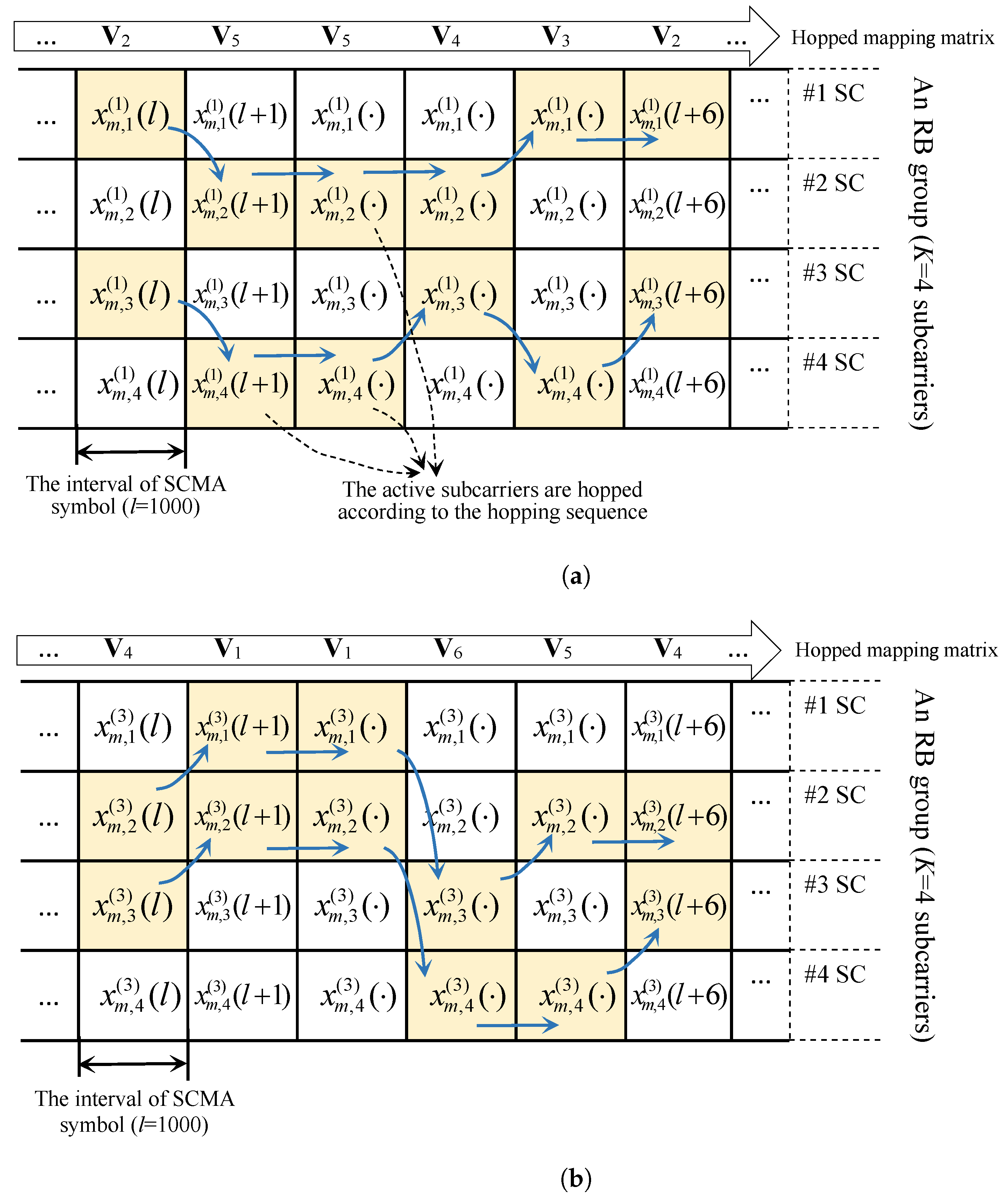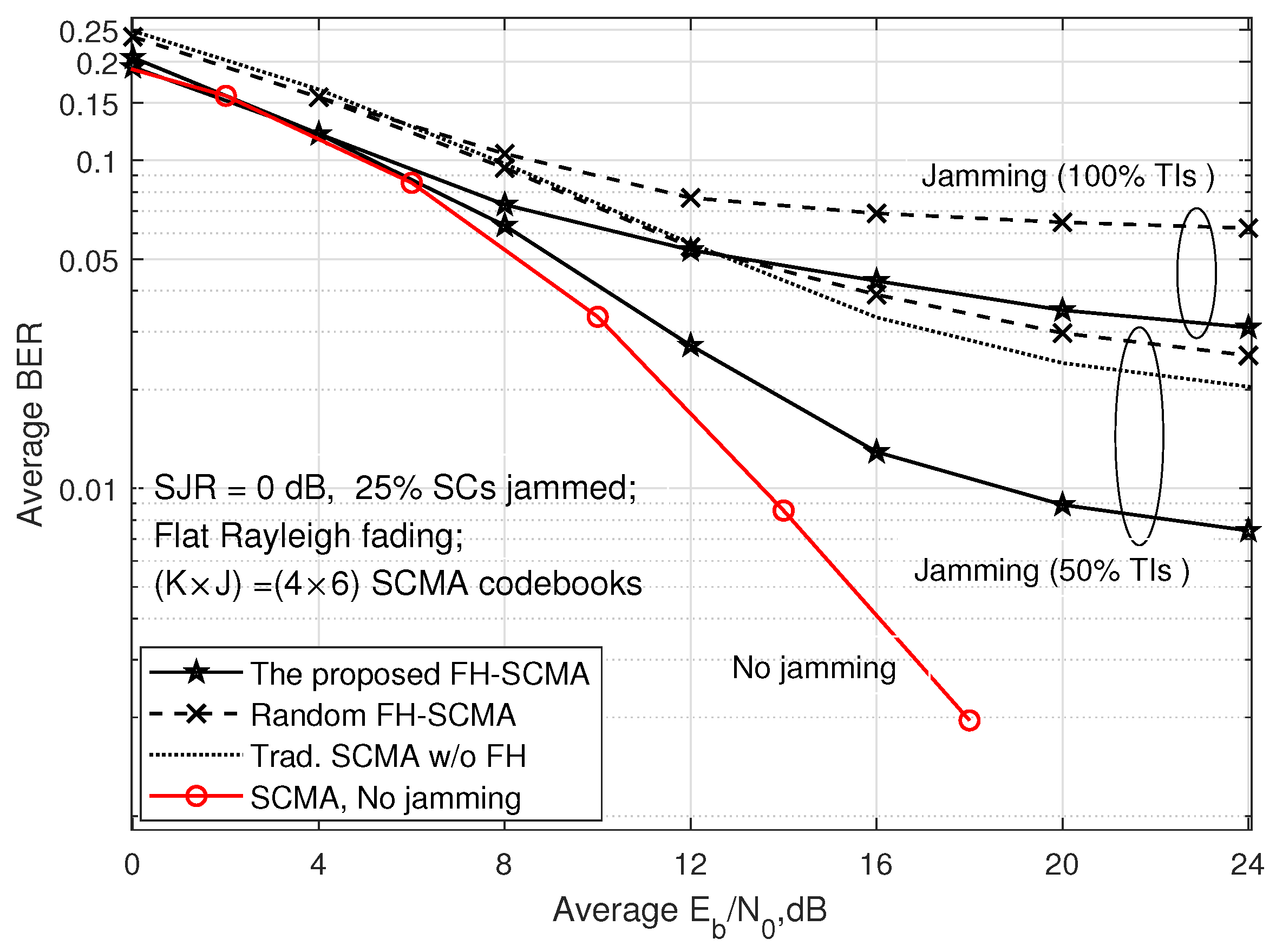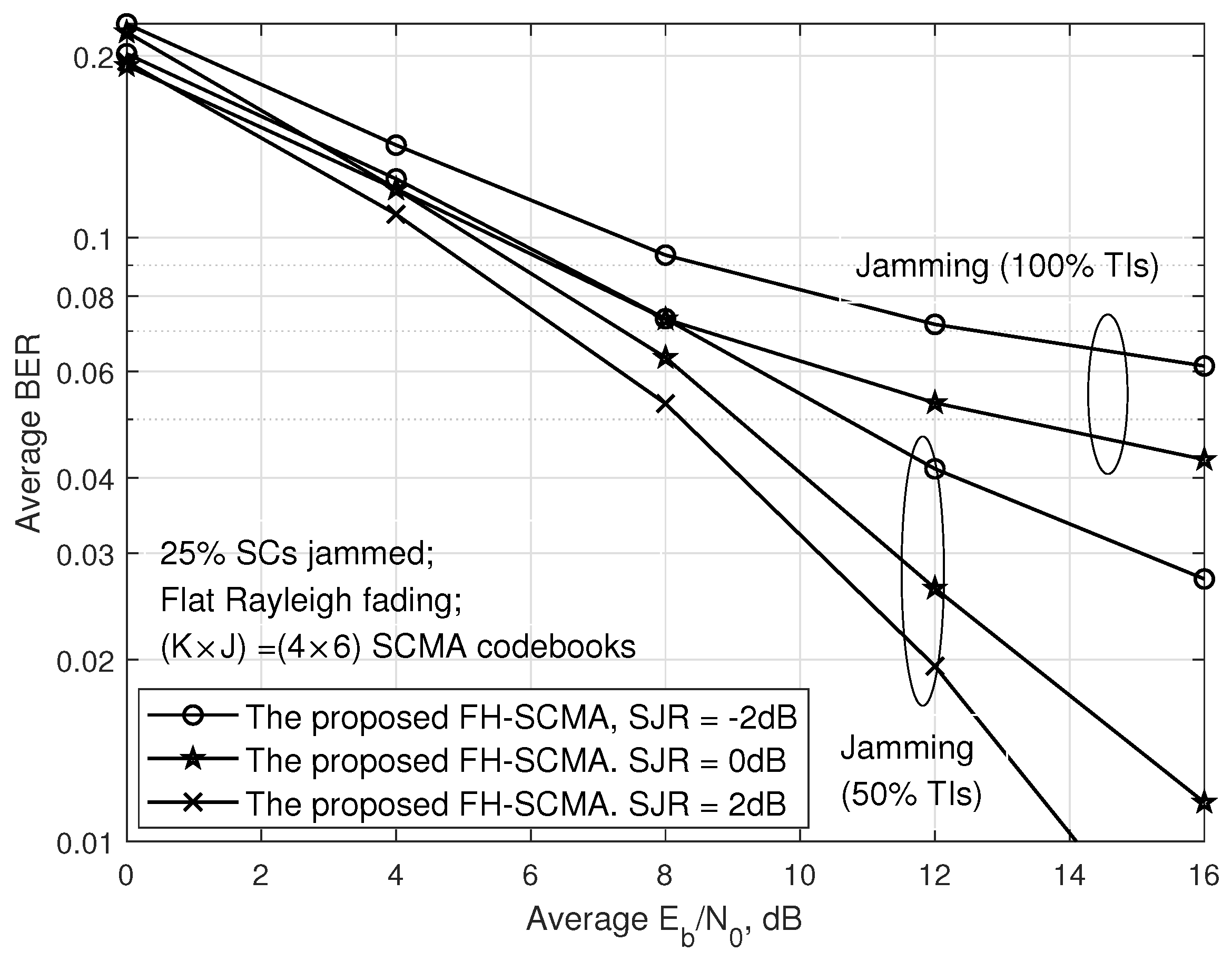Construction of Hopped-Sparse Code Multiple Access Codebooks Based on Chaotic Bernoulli Frequency-Hopping Sequence
Abstract
1. Introduction
2. Problem Description and Related Work
2.1. Problem Descriptions of Traditional SCMA
2.2. Related Work
3. The Integrated Design of the FH Sequence and SCMA Codebooks
3.1. Requirements of FH-SCMA Codebook Design
- Challenge 1: To achieve the (near) optimal MPA performance at the SCMA receiver, the sparsity of the factor graph matrix of the proposed FH-SCMA codebooks should be satisfied.
- Challenge 2: To ensure the security of the FH-SCMA codebooks, the FH sequence and FH-SCMA codebook should have a sufficiently long period and good randomness.
- Challenge 3: The proposed FH-SCMA codebooks should avoid additional collisions of subcarriers because it could result in the deterioration of the MPA performance at the SCMA receiver.
3.2. Construction Algorithm of FH-SCMA Codebooks
- The continuous interval is divided into p non-overlapping sections,where .
- The algorithm mapping the analog sequence to the p-ary sequence is shown as
4. A Case Study: An Example of FH-SCMA Codebooks and Their Properties
- Test 1: Functional testing
- Test 2: Sparsity and uniformity testings of the FH-SCMA codebooks
5. The BER Performance of the Proposed FH-SCMA Codebooks
6. Conclusions and Discussions
- The proposed FH-SCMA codebooks attain a long period and good randomness/ uniformity, since the hopped-SCMA codebooks are controlled by the chaotic FH sequence based on the Bernoulli mapping function. The usage distributions of various SC-combinations obtain the small value of standard deviations. The active sub-carriers are hopped over a given RB group, which enhances the spectral efficiency.
- The sparsity of the proposed FH-SCMA codebooks is maintained perfectly so that the classic MPA multi-user detection can be directly applied to the FH-SCMA receiver without any adjustment. This feature guarantees that FH-SCMA codebooks attain favorable performance with low complexity.
- In aid of the FH technique, the FH-SCMA codebooks (system) can efficiently combat the strong jamming attack (25% SCs and 50% TIs jammed), and the BER performance achieves an acceptable level of compared to other SCMA systems, which is more suitable for the massive user access under the severe electromagnetic environment.
Author Contributions
Funding
Data Availability Statement
Conflicts of Interest
References
- Ding, Z.; Lei, X.; Karagiannidis, G.K.; Schober, R.; Yuan, J.; Bhargava, V.K. A survey on non-orthogonal multiple access for 5G networks: Research challenges and future trends. IEEE J. Sel. Area Commun. 2017, 35, 2181–2195. [Google Scholar] [CrossRef]
- Vameghestahbanati, M.; Marsland, I.; Gohary, R.; Yanikomeroglu, H. Multidimensional constellations for uplink SCMA systems a comparative study. IEEE Commun. Surv. Tutor. 2019, 21, 2169–2194. [Google Scholar] [CrossRef]
- Liu, Z.; Yang, L.L. Sparse or dense: A comparative study of code domain NOMA systems. IEEE Trans. Wirel. Commun. 2021, 20, 4768–4780. [Google Scholar] [CrossRef]
- Zeng, Q.; Chen, J.; Niu, X.; Zhou, L.; Liu, X. Optimal no-hit-zone sequences with wide-gap for improved FHMA systems under follower jamming. IEEE Trans. Commun. 2025, 73, 1493–1495. [Google Scholar] [CrossRef]
- Zeng, Q.; Liu, X. Chaos theory-based NHZ-FH sequence set for quasi-synchronous FHMA system. Electron. Lett. 2017, 53, 1493–1495. [Google Scholar] [CrossRef]
- Lin, C.; Sun, S. Chaotic frequency hopping sequences. IEEE Commun. Lett. 1998, 46, 1433–1437. [Google Scholar]
- Jung, J.; Lim, J. Chaotic standard map based frequency hopping OFDMA for low probability of intercept low probability of intercept. IEEE Commun. Lett. 2011, 15, 1019–1021. [Google Scholar] [CrossRef]
- Bao, J.; Ji, L. New families of optimal frequency hopping sequence sets. IEEE Trans. Inf. Theory 2016, 62, 5209–5224. [Google Scholar] [CrossRef]
- Xu, S.; Mi, J. New constructions for near-optimal sets of frequency-hopping sequences via the Gaussian periods in finite fields. IEEE Access 2022, 10, 18463–18469. [Google Scholar] [CrossRef]
- Niu, X.; Xing, C.; Liu, Y.; Zhou, L. A construction of optimal frequency hopping sequence set via combination of multiplicative and additive groups of finite fields. IEEE Trans. Inf. Theory 2020, 66, 5310–5315. [Google Scholar] [CrossRef]
- Zeng, Q.; Liu, Z.; Liu, X.; Zhong, J.; Xiao, P. Frequency-hopping based SCMA for massive connectivity in multi-cell networks. In Proceedings of the IEEE Vehicle Technology Conference 2021 Fall (VTC 2021-Fall), Helsinki, Finland, 27 September–28 October 2021; pp. 1–6. [Google Scholar]
- Luo, Q.; Liu, Z.; Chen, G.; Xiao, P.; Ma, Y.; Maaref, A. A design of low-projection SCMA codebooks for ultra-low decoding complexity in downlink IoT networks. IEEE Trans. Wirel. Commun. 2023, 22, 6608–6623. [Google Scholar] [CrossRef]
- Huang, C.; Su, B.; Lin, T.; Huang, Y. Downlink SCMA codebook design with low error rate by maximizing minimum Euclidean distance of superimposed codewords. IEEE Trans. Veh. Technol. 2022, 71, 5231–5245. [Google Scholar] [CrossRef]
- Cai, D.; Fan, P.; Lei, X.; Liu, Y.; Chen, D. Multi-dimensional SCMA codebook design based on constellation rotation and interleaving. In Proceedings of the 2016 IEEE 83rd Vehicular Technology Conference ( VTC 2016-Spring), Nanjing, China, 15–18 May 2016; pp. 1–5. [Google Scholar]
- Klimentyev, V.P.; Sergienko, A.B. SCMA codebooks optimization based on genetic algorithm. In Proceedings of the European Wireless 2017, Dresden, Germany, 17–19 May 2017; pp. 1–5. [Google Scholar]
- Deka, K.; Priyadarsini, M.; Sharma, S.; Beferull-Lozano, B. Design of SCMA codebooks using differential evolution. In Proceedings of the 2020 IEEE International Conference on Communications Workshops (ICC Workshops), Dublin, Ireland, 7–11 June 2020; pp. 1–7. [Google Scholar]
- Yu, L.; Fan, P.; Cai, D.; Ma, Z. Design and analysis of SCMA codebook based on star-QAM signaling constellations. IEEE Trans. Veh. Technol. 2018, 67, 10543–10553. [Google Scholar] [CrossRef]
- Vikas, V.; Rajesh, A.; Deka, K.; Sharma, S. A comprehensive technique to design SCMA codebooks. IEEE Commun. Lett. 2022, 26, 1735–1739. [Google Scholar] [CrossRef]
- Bluetooth Special Interest Group (SIG). Bluetooth Specification, 683 Version 5.0. 2016. Available online: http://www.bluetooth.org (accessed on 1 January 2016).
- Torrieri, D.; Talarico, S.; Valenti, M.C. Analysis of a frequency-hopping millimeter-wave cellular uplink. IEEE Trans. Wirel. Commun. 2016, 15, 7089–7098. [Google Scholar] [CrossRef]
- Lin, M.; Yang, M.; Chang, G.C.; Liu, C.Y.; Kwong, Y.S.; C, W. Frequency-hopping CDMA with Reed-Solomon code sequences in wireless communications. IEEE Trans. Commun. 2007, 55, 2052–2055. [Google Scholar] [CrossRef]
- Al-Dweik, A.J.; Sharif, B.S. Exact performance analysis of synchronous FH-MFSK wireless networks. IEEE Trans. Veh. Technol. 2009, 58, 3771–3776. [Google Scholar] [CrossRef]
- Guan, L.; Li, Z.; Si, J.; Hao, B. Analysis of asynchronous frequency hopping multiple-access network performance based on the frequency hopping sequences. IET Commun. 2015, 9, 117–121. [Google Scholar] [CrossRef]
- Ye, W.; Fan, P.; Pengf, D.; Suehiro, N. Theoretical bound on no hit zone of frequency hopping sequences. In Proceedings of the Fifth International Workshop on Signal Design and Its Applications in Communications, Guilin, China, 10–14 October 2011; pp. 115–117. [Google Scholar]
- Guan, L.; Li, Z.; Si, J.; Hao, B. Strong no-hit-zone sequences for improved quasi-orthogonal FHMA systems: Sequence design and performance analysis. IEEE Trans. Commun. 2019, 67, 5336–5345. [Google Scholar]
- Liu, X.; Zhou, L.; Zeng, Q. No-hit-zone frequency hopping sequence sets with respect to aperiodic Hamming correlation. Electron. Lett. 2018, 54, 212–213. [Google Scholar] [CrossRef]
- Zhou, L.; Zhang, C.; Zeng, Q.; Liu, X.; Wu, H. Optimal low-hit-zone frequency-hopping sequence sets with wide-gap for FHMA systems under follower jamming. IEEE Commun. Lett. 2022, 26, 969–973. [Google Scholar] [CrossRef]
- Su, H.; Zhao, M.; Fang, X.; Zhang, P. Frequency hopping non-orthogonal multiple access. In Proceedings of the 2023 International Conference on Wireless Communications and Signal Processing (WCSP), Hangzhou, China, 2–4 November 2023; pp. 990–995. [Google Scholar]
- Li, W.; Zheng, Z.; Luan, S.; Pan, G. An anti-jamming SCMA method using Turbo-Hadamard codes for satellite communications. In Proceedings of the 2024 International Conference on the Frontiers of Electronic, Electrical and Information Engineering (ICFEEIE), Huangshan, China, 21–23 June 2024; pp. 1–6. [Google Scholar]
- Qin, T.; Yang, Z.; Liang, J.; Han, K.; Hu, J. Receiver Designs for SC-SCMA Systems Over Frequency Selective Channels. In Proceedings of the IEEE 99th Vehicular Technology Conference 2024 Spring (VTC2024-Spring), Singapore, 24–27 June 2024; pp. 1–6. [Google Scholar]
- Bai, Z.; Li, B.; Yang, M.; Yan, Z.; Zuo, X.; Zhang, Y. FH-SCMA: Frequency hopping based sparse code multiple access for next generation internet of things. In Proceedings of the IEEE Wireless Communications and Networking Conference (IEEE WCNC), San Francisco, CA, USA, 19–22 March 2017; pp. 1–6. [Google Scholar]
- Yang, K.; Zeng, Q.; Liu, X.; Fang, K.; Niu, X. Design and Analysis of Inter-RBs Hopping SCMA System under Jamming Attacks. In Proceedings of the IEEE 22nd International Conference on Communication Technology, Nanjing, China, 11–14 November 2022; pp. 1–6. [Google Scholar]




| The Combinations of SCs | The Usage Number of SC-Combinations | |||
|---|---|---|---|---|
| #1 UE | #3 UE | #6 UE | ||
| 340 | 349 | 338 | ||
| 338 | 314 | 335 | ||
| 335 | 340 | 344 | ||
| 324 | 338 | 349 | ||
| 329 | 335 | 314 | ||
| 334 | 324 | 320 | ||
| Total | 2000 | 2000 | 2000 | |
| Standard deviations | 5.38 | 11.36 | 12.49 | |
Disclaimer/Publisher’s Note: The statements, opinions and data contained in all publications are solely those of the individual author(s) and contributor(s) and not of MDPI and/or the editor(s). MDPI and/or the editor(s) disclaim responsibility for any injury to people or property resulting from any ideas, methods, instructions or products referred to in the content. |
© 2025 by the authors. Licensee MDPI, Basel, Switzerland. This article is an open access article distributed under the terms and conditions of the Creative Commons Attribution (CC BY) license (https://creativecommons.org/licenses/by/4.0/).
Share and Cite
Zhao, P.; Xu, Z.; Zeng, Q. Construction of Hopped-Sparse Code Multiple Access Codebooks Based on Chaotic Bernoulli Frequency-Hopping Sequence. Electronics 2025, 14, 1895. https://doi.org/10.3390/electronics14091895
Zhao P, Xu Z, Zeng Q. Construction of Hopped-Sparse Code Multiple Access Codebooks Based on Chaotic Bernoulli Frequency-Hopping Sequence. Electronics. 2025; 14(9):1895. https://doi.org/10.3390/electronics14091895
Chicago/Turabian StyleZhao, Peiyi, Zhimin Xu, and Qi Zeng. 2025. "Construction of Hopped-Sparse Code Multiple Access Codebooks Based on Chaotic Bernoulli Frequency-Hopping Sequence" Electronics 14, no. 9: 1895. https://doi.org/10.3390/electronics14091895
APA StyleZhao, P., Xu, Z., & Zeng, Q. (2025). Construction of Hopped-Sparse Code Multiple Access Codebooks Based on Chaotic Bernoulli Frequency-Hopping Sequence. Electronics, 14(9), 1895. https://doi.org/10.3390/electronics14091895






